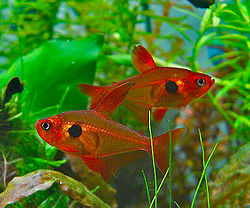Characidae
Family of fishes From Wikipedia, the free encyclopedia
Characidae, the characids or characins, is a family of freshwater subtropical and tropical fish belonging to the order Characiformes. The name "characins" is a historical one,[2] but scientists today tend to prefer "characids" to reflect their status as a, by and large, monophyletic group (at family rank). To arrive there, this family has undergone much systematic and taxonomic change. Among those fishes remaining in the Characidae currently are the tetras, comprising the very similar genera Hemigrammus and Hyphessobrycon, as well as a few related forms, such as the cave and neon tetras. Fish of this family are important as food in several regions, and also constitute a large percentage of captive freshwater aquarium fish species.[3]
| Characidae | |
|---|---|
 | |
| Red phantom tetras (Hyphessobrycon sweglesi) | |
| Scientific classification | |
| Domain: | Eukaryota |
| Kingdom: | Animalia |
| Phylum: | Chordata |
| Class: | Actinopterygii |
| Order: | Characiformes |
| Suborder: | Characoidei |
| Family: | Characidae Latreille, 1825 |
| Subfamilies[1] | |
|
Aphyocharacinae | |
These fish vary in length; many are less than 3 cm (1.2 in). One of the smallest species, Hyphessobrycon roseus, grows to a maximum length of 1.9 cm.[4]
These fish inhabit a wide range and variety of habitats. New World fishes, they originate in the Americas, ranging from southwestern Texas and México through most of Central and South America, including such major waterways as the Amazon and Orinoco Rivers.[3] Many of these fish come from rivers and tributaries, while the blind cave tetra, for example, inhabits flooded caves.
Systematics
Summarize
Perspective
This section needs additional citations for verification. (January 2024) |
| Phylogeny of Characidae from Melo et al. 2015[5] with clade names from van der Laan 2017.[6] | |||||||||||||||||||||||||||||||||||||||
|
This family has undergone a large amount of systematic and taxonomic change. More recent revision has moved many former members of the family into their own related but distinct families – the pencilfishes of the genus Nannostomus are a typical example, having now been moved into the Lebiasinidae, the assorted predatory species belonging to Hoplias and Hoplerythrinus have now been moved into the Erythrinidae, and the sabre-toothed fishes of the genus Hydrolycus have been moved into the Cynodontidae. The former subfamily Alestiinae was promoted to family level (Alestiidae) and the subfamilies Crenuchinae and Characidiinae were moved to the family Crenuchidae.[3]

Other fish families that were formerly classified as members of the Characidae, but which were moved into separate families of their own during recent taxonomic revisions (after 1994) include Acestrorhynchidae, Anostomidae, Chilodontidae, Citharinidae, Ctenoluciidae, Curimatidae, Distichodontidae, Gasteropelecidae, Hemiodontidae, Hepsetidae, Parodontidae, Prochilodontidae,[7] Serrasalmidae, and Triportheidae.[8]
The larger piranhas were originally classified as belonging to the Characidae, but various revisions place them in their own related family, the Serrasalmidae. This reassignment has yet to enjoy universal acceptance, but is gaining in popularity among taxonomists working with these fishes. Given the current state of flux of the Characidae, a number of other changes will doubtless take place, reassigning once-familiar species to other families. Indeed, the entire phylogeny of the Ostariophysi – fishes possessing a Weberian apparatus – has yet to be settled conclusively. Until that phylogeny is settled, the opportunity for yet more upheavals within the taxonomy of the characoid fishes is considerable.
Classification
Summarize
Perspective
Phylogeny




(Hemigrammus hyanuary)


(Nematobrycon palmeri)
Taxonomy
The subfamilies and tribes currently recognized by most if not all authors, and their respective genera, are:[6]
Subfamily Spintherobolus clade
Subfamily Stethaprioninae
- Tribe Rhoadsiini [Astyanax clade]
- Tribe Stygichthyini [Jupiaba clade]
- Tribe Pristellini [Hemigrammus clade; Aphyoditini]
- Tribe Stethaprionini
- Tribe Gymnocharacini
- Tribe Scissorini
Subfamily Stevardiinae
- Tribe Eretmobryconini
- Tribe Xenurobryconini
- Tribe Argopleura clade
- Tribe Glandulocaudini
- Tribe Stevardiini
- Tribe Hemibryconini
- Tribe Creagrutini
- Tribe Landonini
- Tribe Phenacobryconini
- Tribe Trochilocharacini
- Tribe Diapomini
Subfamily Characinae
- Tribe Protocheirodontini
- Tribe Pseudocheirodontini
- Tribe Aphyocharacini
- Tribe Cheirodontini
- Tribe Compsurini
- Tribe Exodontini
- Tribe Tetragonopterini
- Tribe Characini
Subfamily Pristellinae[14]
Former members
The Chalceidae, Iguanodectidae, Bryconidae and Heterocharacinae are the most recent clades to be removed in order to maintain a monophyletic Characidae.[8]
Subfamily Iguanodectinae moved to Iguanodectidae
Subfamily Heterocharacinae moved to Acestrorhynchidae
Subfamily Bryconinae moved to Bryconidae
Subfamily Salmininae moved to Bryconidae
Genera incertae sedis
- Chalceus moved to Chalceidae
Genera incertae sedis
A large number of taxa in this family are incertae sedis. The relationships of many fish in this family – in particular species traditionally placed in the Tetragonopterinae, which had become something of a "wastebin taxon" – are poorly known,[3] a comprehensive phylogenetic study for the entire family is needed.[1] The genera Hyphessobrycon, Astyanax, Hemigrammus, Moenkhausia, and Bryconamericus include the largest number of currently recognized species among characid fishes that are in need of revision;[15] Astyanax and Hyphessobrycon in the usual delimitation are among the largest genera in this family.[3] These genera were originally proposed between 1854 and 1908 and are still more or less defined as by Carl H. Eigenmann in 1917, though diverse species have been added to each genus since that time. The anatomical diversity within each genus, the fact that each of these generic groups at the present time cannot be well-defined, and the high number of species involved are the major reasons for the lack of phylogenetic analyses dealing with the relationships of the species within these generic "groups".[15]
References
Wikiwand - on
Seamless Wikipedia browsing. On steroids.
